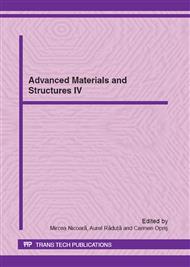[1]
J.Camparo, The Rubidium atomic clock and basic research, Physics Today 11 (2007) 33-40.
DOI: 10.1063/1.2812121
Google Scholar
[2]
R.Lutwak, P.Vlitas, M.Varghese, M.Mescher, M.Serkland, D.K. Peake, The MAC – a miniature atomic clock, in: Proc.Joint IEEE Int. Freq. Contr. Symp. Precise Time Time Interval (PTTI) Syst. Appl. Meeting, Vancouver, Canada 2005, 752-757.
DOI: 10.1109/freq.2005.1574029
Google Scholar
[3]
S. Knappe, V. Shah, P. Schwindt, L. Hollberg, J. Kitching, A microfabricated atomic clock, Appl. Phys. Lett. 85 (2004) 1460-1462,.
DOI: 10.1063/1.1787942
Google Scholar
[4]
S.Knappe, MEMS atomic clocks, in: Comprehensive Microsystems, Y.Gianchandani, O.Tabata, H.Zappe (ed.), Elsevier (2007) 571-612.
DOI: 10.1016/b978-044452190-3.00048-3
Google Scholar
[5]
S. Knappe, P.D.D. Schwindt, V. Shah†, L. Hollberg, and J. Kitching, A chip-scale atomic clock based on 87Rb with improved frequency stability, Opt. Express 13 (2005) 1249–1253,.
DOI: 10.1364/opex.13.001249
Google Scholar
[6]
R. Lutwak et al, The chip-scale atomic clock-low-power physics package, Proc. Precision Time and Time Interval (PTTI) Syst. Applic. Mtg, Washington, DC, 2004.
Google Scholar
[7]
Y. Imanaka, Multilayered Low-Temperature Co-fired Ceramics (LITCC) technology, first ed., Springer, New York, 2005.
Google Scholar
[8]
T. Maeder, Y. Fournier , S. Wiedmer, H. Birol, C. Jacq, P. Ryser , 3D structuration of LTCC / thick-film sensors and fluidic devices, Proc. 3rd International Conference on Ceramic Interconnect and Ceramic Microsystems Technologies (CICMT), Denver, USA, 2007:THA13.
DOI: 10.4028/www.scientific.net/kem.336-338.1849
Google Scholar
[9]
Y.Fournier, G.Boutinard-Rouelle, N.Craquelin, T.Maeder, P.Ryser, SMD pressure and flow sensor for compressed air in LTCC technology with integrated electronics, Procedia Chem. 2009 1471-1474.
DOI: 10.1016/j.proche.2009.07.367
Google Scholar
[10]
J. Zhong, H.H. Bau, Thick film thermistors printed on low temperature co-fired ceramic tapes, Am. Ceram. Soc. Bull. 80 (2001) 39–42.
Google Scholar
[11]
M. Miyamoto, J. Sumikawa, T. Akiyoshi, T. Nakamura, Effect of axial heat conduction in a vertical flat plate on free convection heat transfer. Int. J. Heat Transfer Mass Transfer, 22 (1980) 1545–1553.
DOI: 10.1016/0017-9310(80)90158-1
Google Scholar
[12]
X.F. Peng, G.P. Peterson, Convective heat transfer and flow friction for water flow in microchannel structures. Int.J. Heat Transfer Mass Transfer, 39 (1996) 2599–2608.
DOI: 10.1016/0017-9310(95)00327-4
Google Scholar
[13]
DG Cahill, Thermal conductivity measurement from 30 to 750 K: the 3ω method, Review of Scientific Instruments, 61 (1990) 802-808,.
DOI: 10.1063/1.1141498
Google Scholar
[14]
T. C. Harman, J. H. Cahn, and M. J. Logan, Measurement of Thermal Conductivity by Utilization of the Peltier Effect , J. Appl. Phys. 30 (1959) 1351-1359.
DOI: 10.1063/1.1735334
Google Scholar
[15]
Zampino M.A., Kandukuri R., Jones W.K., High Performance Thermal Vias in LTCC Substrates, Proc. Inter Society Conf. on Thermal Phenomena, 2002, 179-185
DOI: 10.1109/itherm.2002.1012455
Google Scholar


